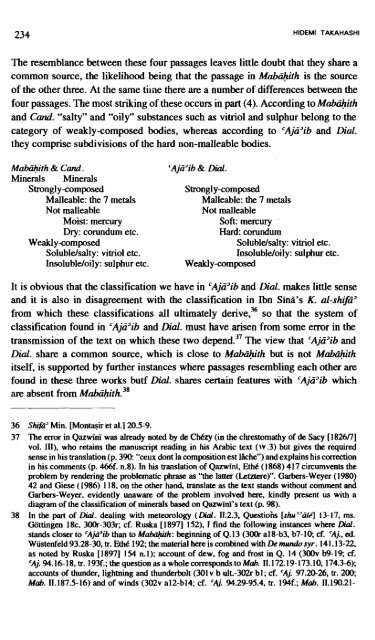doc.pdf
doc.pdf
doc.pdf
Create successful ePaper yourself
Turn your PDF publications into a flip-book with our unique Google optimized e-Paper software.
The resemblance between these four passages leaves little doubt that they share a<br />
common source, the likelihood being that the passage in Mab4ith is the source<br />
of the other three. At the same time there are a number of differences between the<br />
four passages. The most striking of these occurs in part (4). According to Mub@aith<br />
and Cand. "salty" and ''oily" substances such as vitriol and sulphur belong to the<br />
category of weaklycomposed bodies, whereas according to 'Aj&'ib and Dial.<br />
they comprise subdivisions of the hard non-malleable bodies.<br />
Mabcijzith & Cand.<br />
Minerals Minerals<br />
Strongl y-composed<br />
Malleable: the 7 metals<br />
Not malleable<br />
Moist: mercury<br />
Dry: corundum etc.<br />
Weaklycomposed<br />
Solubldsalty: vitriol etc.<br />
Insolubldoily: sulphur etc.<br />
cA~3ib & Dial.<br />
Strongl y-composed<br />
Malleable: the 7 metals<br />
Not malleable<br />
Soft: mercury<br />
Hard: corundum<br />
Solubldsalty: vitriol etc.<br />
Insolubldoily: sulphur etc.<br />
Weakly-composed<br />
It is obvious that the classification we have in 'Aji'ib and Dial. makes little sense<br />
and it is also in disagreement with the classification in Ibn Sins's K. al-shijii'<br />
from which these classifications all ultimately derive,36 so that the system of<br />
classification found in 'Aja'ib and Dial. must have arisen from some error in the<br />
transmission of the text on which these two depend.37 The view that 'Aji'ib and<br />
Dial. share a common source, which is close to Mwth but is not Mahihith<br />
itself, is supported by further instances where passages resembling each other are<br />
found in these three works butf Dial. shares certain features with 'Aja'ib which<br />
are absent from ~ubhhith.~*<br />
Shifd' Min. [Montqir et al.] 20.5-9.<br />
The error in Qazwini was already noted by de Chdzy (in the chrestomathy of de Sacy [1826/7]<br />
vol. 111). who retains the manuscript reading in his Arabic text (\V.3) but gives the requircd<br />
sense in his translation (p. 390: "ceux dont la composition est llche") and explains his correction<br />
in his comments (p. 466f. n.8). In his translation of Qazwini, EthC (1 868) 41 7 circumvents the<br />
problem by rendering the problematic phrase as "the latter (Letztere)". Garbers-Weyer (1980)<br />
42 and Giese (1986) 118, on the other hand, translate as the text stands without .comment and<br />
Garbers-Weyer, evidently unaware of the problem involved here, kindly present us with a<br />
diagram of the classification of minerals based on Qazwini's text (p. 98).<br />
In the part of Did. dealing with meteorology (M. 11.2.3. Questio'ns [shu"'aW 13-17, ms.<br />
Gottingen 18c. 300r-303r; cf. Ruska [I8971 152), 1 find the following instances where Dial.<br />
stands closer to 'Ajd'ib than to Md@ith: beginning of Q. 13 (300r a1 8-b3, b7-10; cf. 'Aj.. ed.<br />
Wiistenfeld 93.28-30, tr. Ethk 192; the material here is combined with De rmurdo syr. 14 1.13-22,<br />
as noted by Ruska [I8971 154 n.1); account of dew, fog and frost in Q. 14 (300v b9-19; cf.<br />
'Aj. 94.16-1 8, tr. 193f.; the question as a whole corresponds to Mob. 11.172.19- 173.10.174.3-6);<br />
accounts of thunder, lightning and thunderbolt (301v b ult.-302r bl; cf. 'Aj. 97.20-26, tr. 200;<br />
Mob. 11.187.5-16) and of winds (302v a12-b14; cf. 'Ai. 94.29-95.4, tr. 194f.; Mob. 11.190.21-
















